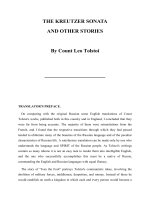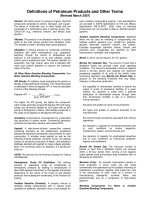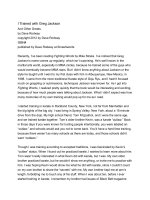Risky business corruption fraud terrorism and other threats to global business
Bạn đang xem bản rút gọn của tài liệu. Xem và tải ngay bản đầy đủ của tài liệu tại đây (5.46 MB, 316 trang )
Risky Business:
Corruption, Fraud,
Terrorism and other
Threats to Global
Business
Stuart Poole-Robb
and
Alan Bailey
Kogan Page
Risky Business
Corruption, Fraud,Terrorism and
other Threats to Global Business
Risky Business
Corruption, Fraud,Terrorism and other
Threats to Global Business
Stuart Poole-Robb
and
Alan Bailey
Publisher’s note
Every possible effort has been made to ensure that the information contained in this
handbook is accurate at the time of going to press, and the publishers and authors cannot
accept responsibility for any errors or omissions, however caused. No responsibility for
loss or damage occasioned to any person acting, or refraining from action, as a result of
the material in this publication can be accepted by the editor, the publisher or any of the
authors.
First published in 2002
Apart from any fair dealing for the purposes of research or private study, or criticism or
review, as permitted under the Copyright, Designs and Patents Act, 1988, this
publication may only be reproduced, stored or transmitted, in any form, or by any
means, with the prior permission in writing of the publisher, or in the case of
reprographic reproduction in accordance with the terms of licences issued by the
Copyright Licensing Agency. Enquiries concerning reproduction outside those terms
should be sent to the publishers at the undermentioned address:
Kogan Page Ltd
120 Pentonville Road
London N1 9JN
www.kogan-page.co.uk
© Kogan Page and Contributors 2002
British Library Cataloguing in Publication Data
A CIP record for this book is available from the British Library
ISBN 0 7494 3817 7
Typeset by Saxon Graphics Ltd, Derby
Printed and bound in Great Britain by Biddles Ltd, Guildford and King’s Lynn
www.biddles.co.uk
Contents
Foreword
The Rt. Hon. Sir John Wheeler PC JP DL, Chairman, Service Authorities
for the National Criminal Intelligence Service and National Crime Squad
ix
Foreword
Dan Pinck
xi
Acknowledgements
xiii
Introduction
1
Part One: Invisible Risk and its Impact on Investment
1. Operating in overseas markets
2. Invisible risks
Grey Area Dynamics™
MIG’s ten GADs and their sub sections
The iceberg
3. The problem with strategy
v
7
10
12
14
19
23
Contents
4.
5.
6.
7.
8.
9.
10.
Direction
Information collection
Analysis and planning
Bargaining
Decision-making
Understanding culture
Business integration
Case study: South Korea
Bureaucracy, corruption and Foreign Direct Investment
Bureaucracy and liberality of investment regimes
Corruption
Case study: Indonesia (1)
Case study: Indonesia (2)
Legal safeguards
Case study: Poland
Case study: CIS/Ukraine/Russia
Criminal activities
Counterfeiting and fraud
Case study: parallel trading and product diversion
Case study: Russia
Case study: European Union
The good, the bad and the unethical
Case study: Burma
Case study: Royal Dutch/Shell
Other headaches
Extremism
Unfair competition
Case study: Russia
Case study: industrial espionage
A little light relief
Part Two: The World’s Troublespots
11. Introduction
12. Origins of the threat to business
Religious fanaticism and creeping Islam
International organized crime syndicates
vi
24
25
26
35
36
38
41
45
49
53
54
62
64
69
73
75
79
85
89
93
94
96
99
101
105
111
115
122
123
125
143
147
147
148
Contents
13.
14.
15.
16.
Political terrorist groups
Global scenario update
Risk ratings
Middle East – the Saudi domino effect
Instability in Saudi Arabia
Expanded US operations against Iraq
Re-radicalization in Iran
Higher intensity Israeli-Palestinian conflict
Instability in Turkey
17. Latin America
Regional recession
18. Asia Pacific
Indo-Pakistani conflict over Kashmir
US operations extended into Pakistan
Sino-Indian war as a result of Indo-Pakistani war
A widened Sino-Indian war
A new Taiwan crisis
A Korean crisis
Islamic revolution in Indonesia
19. The lesser risks – country by country
Asia and the Far East
Europe and the Former Soviet Union
The Middle East
Latin America
Africa
151
153
156
159
159
163
164
167
169
171
171
174
174
177
179
181
183
188
189
191
191
197
200
210
217
Part Three: Threat and Defence
20. Introduction
Extortion/blackmail
Kidnapping or hostage-taking
Political terrorism
21. The defence of buildings, personnel and stock
The threat from direct action groups
Protection after the blast
Chemical and biological threats
Evacuation of buildings on receipt of a warning or after
terrorist attack
227
227
228
229
230
230
235
239
240
vii
Contents
Defence of stock
Cybercrime
22. Proactive and precautionary measures
Personal security
International travel
Documents and currency
Medical
Airport safety
Hotel safety
Street awareness
Security when mobile
Portable computer and mobile telephone security
Security at home
Child safety
Leisure
Women travellers
Attack and kidnap for ransom
Personal reactions
Coping with captivity
Safeguarding your family
Response to a kidnap call
Dealing with bombs
246
247
249
250
250
251
252
252
253
254
257
260
261
262
263
263
264
264
266
270
273
274
Part Four: Conclusions
23. Conclusions – So Where Do We Stand Now?
279
Appendices
References
About the authors
About MIG
Merchant International Group (MIG) publications
Index
287
288
289
291
293
viii
Foreword
A lifetime of involvement in the fight against crime has taught me the value
of intelligence; carefully gathered information that is corroborated, analysed
and used to good effect. The same value attaches to intelligence that
corrects the often-held misconceptions about the influences on commercial investment in overseas markets.
The word ‘globalization’ has a particular meaning for the large multinational corporations; as it has for those of us who recognize that crime and
terrorism now cross frontiers apparently with relative ease. Crime and
terrorism are not the only enemies of those with international commercial
enterprise in mind. The concept of Grey Area Dynamics™ described in
this book lists other influences such as bureaucracy, corruption, unfair
competition, unfair trading, counterfeiting and the effects of cultural, political and religious differences that impinge on commercial decision-making.
The concept covers all of those legal and illegal, passive and active influences that can affect success. The range of those influences is wide and,
frankly, disturbing.
Since the tragic events of 11 September 2001 in New York and
Washington, there is a new awareness of the risk of action by extremists of
ix
Foreword
all types. Serious though that threat may be, the long list of threats or risks
to commerce is equally serious; and demands greater board attention and,
perhaps, a non-conventional approach to due diligence appraisals. Sadly,
there is a degree of arrogance, naivety and certainly ignorance in some
international boardrooms.There is, of course, defence against the risks and
the first line of that defence is awareness among the decision-makers and
those they employ.To ignore the risks could be fatal – to both the business
and to individuals as experience has shown. This book provides a health
warning, and awareness and intelligence in abundance.
The Rt. Hon. Sir John Wheeler, PC, JP, DL, Chairman, Service Authorities
for the National Criminal Intelligence Service and National Crime Squad
x
Foreword
Make no mistake: the intelligent executive of a multi-national company
knows that there’s no panacea for eliminating risks in extra-national activities. The global situation is too complex to allow that. No matter how
enticing the opportunities, there are so many imponderables that risk is the
order of the day.
Risky Business is a practical guide to recognizing risks and thereby
minimizing some of them.The authors of this book make no facile claims
or promises.What they offer is a sensible, highly pragmatic guide to identifying and assessing the risks that can defeat foreign operations. Their
experiences warrant your attention.
Stuart Poole-Robb and Alan Bailey have developed through many years
of experience an almost all-encompassing geopolitical, due diligence
operation that accounts for a sober myriad of vital factors. I consider their
programme complementary and supplementary to other necessary components of information-gathering. In translating information into corporate
intelligence, they have a way of looking at risky solutions and dealing with
them with lowered risk.That’s as much as we can ask.
xi
Foreword
Dan C Pinck served in the Office of Strategic Services, the forerunner of the
Central Intelligence Agency. He is the author of ‘Stalking the History of the
Office of Strategic Services’. A memoir of his work behind enemy lines will be
published in 2002. He is a member of the Special Forces Club.
xii
Acknowledgements
Many people have contributed to the creation of this book. First, there are
the sources of the information that the book contains – nearly 3,000 of
them across an increasingly violent and risk-laden world. Then there are
those who make up the board and permanent staff of the Merchant
International Group (MIG) – and, particularly, Dr Rashna Writer, the
Group’s Head of Global Risks, whose skilful pen makes sense of the mass
of material received at MIG every day. There are those who contributed
handsomely to the early years of MIG and shared some of the hairier
moments – Ian Henderson, Franc Milburn and a host of others.
There are many more. Maria Muñoz who strung everything together,
the contributions of Major Mike Coldrick, MBE, GM, DSA, and Gregory
Craig, RIBA, on the structural security of buildings, Mike Hussey and Tony
Partington of Canary Wharf Group plc and the editorial hand of Jonathan
Reuvid of Kogan Page which guided all of us towards early publication –
our thanks are due to all of them.
Stuart Poole-Robb and Alan Bailey
Belgravia
January 2002
xiii
Introduction
The tragic events of 11 September 2001 in New York and Washington, and
their aftermath, have brought into sharp focus the risks to businesses and
employees in international markets. The risks are not confined to the
actions of a few fanatical terrorists. They encompass a range of activity
arising from different cultures and attitudes.They stem from the willingness
or otherwise of governments to strengthen weaknesses in policing, judicial
systems and anti-terrorism and to stamp out organized crime, corruption,
unfair trading, counterfeiting, cronyism, bureaucracy and civil unrest.
All of these things exist to some degree in every country of the world.
Through its international network – both official and clandestine – the
Merchant International Group has developed, and continues to develop, an
unparalleled knowledge of the risks facing international businesses and
those employed by them.The group publishes regular fortnightly, monthly
and annual risk updates and analyses of ‘invisible risks’ in specific countries
from its own unique perspective (details of which can be found at the back
of this book). In addition, the group acts for many major international
corporations in identifying, analysing and evaluating risks before and after
1
Introduction
investment and determining likely threats to success and safety well beyond
the norms of due diligence.
Risk is a word in common use. Its definition includes hazard, danger,
exposure to mischance or peril – and, more particularly, the chance or
hazard of commercial or personal loss. Risk is, of course, a matter of
perception – and perception is, too often, clouded by expertise and by the
narrow limits of professional specialization. Today, we are making more
significant decisions in an even more perilous market knowing far less than
ever before – and that cannot be right. The optimistic entrepreneur, the
finance director, the security consultant, the lawyer – all will perceive and
measure risk from different standpoints. Their views are influenced by
current news and media opinion – often totally subjective – and the
traumas and experiences of their personal and working lives from the time
they were ‘mewling and puking in the nurse’s arms’.
It follows that total agreement on commercial strategy and risk assessment is often hard to reach – even after the most careful standard due
diligence analysis. Some contributors to the process of strategic decisionmaking will discount the risks that their colleagues may regard as significant. In the past, there was, too often, an assumption that differences in
history, culture and religion mattered little. The tragic events of 11
September 2001 in New York and Washington will have weakened that
former assumption. But there is rather more risk than those three basic
differences might suggest.
The Merchant International Group (MIG) has a simple tag line – ‘We
look at the world differently’. Through a network of nearly 3000 informants and operatives – both official and clandestine – in more than 140
countries, MIG gathers information. It then seeks corroboration and, after
analysis, that information becomes intelligence. From that solid base, MIG
developed Grey Area Dynamics™ – a method of risk assessment and
measurement well beyond standard due diligence.
There are over 100 headings in MIG’s listing of Grey Area Dynamics™
– covering legal, illegal, active and passive influences on risk.They include
risk to investment, buildings, stock and personnel. This book deals with
each dynamic and each risk in detail and measures the degree of risk in
terms of world geography, culture, religion, politics and economies. It seeks
to be comprehensive because the first defence against risk is total awareness.
2
Introduction
Total awareness must be followed, in some respects, by training, particularly
in relation to employees and their families who may be at serious and
continuing risk in some locations.
There are defences against risk that are possible to build – some in
relation to the structures in which people work and live, others in defence
of stock, the security of personnel and their families and then the whole
range of influences on success covered by what MIG calls its Grey Area
Dynamics™. All of this is explained in detail on the pages that follow.
These pages contain current intelligence as at the date of publication. We
must all recognize that the world in which we live and work is affected by
shifting influences – influences which intensify or change in other ways all
too frequently to bring and sustain varying degrees of risk in different
locations and affecting different commercial enterprises.
There is a standard list of threats that can be applied to every country or,
indeed, to every commercial venture. Standard due diligence has, in the
past, not been diligent enough – and, because the world since 11
September 2001 will never be the same again, there has to be a new
emphasis on commercial intelligence. The word ‘intelligence’ must not be
confused with ‘information’. Before it becomes reliable intelligence, information must be collated, corroborated, analysed and applied to a given set
of circumstances, each measured against the yardsticks of risk. And risk is
not always related to what was known yesterday. An unthinking statement
by a politician can echo round the world in an hour and intensify immediate risk to commercial and industrial interests. It is, sadly, that kind of world.
Religious fanaticism and political extremism are clearly a vital part of
risk assessment – part of the weighting applied to global and national risk
through MIG’s measurement of Grey Area Dynamics™. Political extremism can often be transient although long-lasting – the problems of
Northern Ireland are a mix of religious and political intolerance. Religious
fanaticism is likely to be with us forever. Islam, for example, is currently the
world’s fastest growing religion whereas Christianity, in all of its forms, is
allegedly in serious decline. But there is another dimension to both
religious and political extremism – the criminal dimension through theft,
extortion, kidnap and a range of activities that line the coffers of whatever
sect or group is involved. Today, countries’ special forces, trained by the
special forces of US and UK, freelance and act for drug cartels, organized
3
Introduction
crime and for themselves. Kidnap and ransom have become a profitmaking business.
It is not, therefore, surprising to find some political groups still making a
good living out of criminal activity. Good livings are not easy to give up –
and, whatever political accommodation is made to meet the stated aims,
there is unlikely to be an end to the criminal activity that has bolstered
incomes for twenty years or so. Some religious groups are of the same mind
whatever their professed ideals – and their methods are just as efficient.
Terrorism and crime are the headline-grabbing activities – but there are
other, more insidious, risks capable of inflicting damage to an investment.
Bureaucracy – the gagging inefficiency of red tape – is one. Cronyism –
favouritism in political appointments and the letting of contracts – is
another. Bribery and corruption – sometimes on a massive scale – are
endemic in many parts of the world. All of these things are part of Grey
Area Dynamics™, which the commercial strategists ignore at their peril.
The war declared on international terrorism after the events of 11
September 2001 is both a physical and a political one. However long that
war may last, the commercial war will last for much longer – the war
against commercial risk in international markets through extremism,
corruption, crime, cronyism, counterfeiting and all those influences logged
under MIG’s Grey Area Dynamics™.
Read on – it’s a serious business.
4
Part One
Invisible Risk and its Impact
on Investment
1
Operating in overseas markets
Business strategy and operations in non-domestic markets involve risks.
Indeed, all non-domestic investment and associated activities are risky
business.The markets concerned are attractive because they offer opportunities for rapid growth, lower production costs and potentially higher
returns. At the same time, these markets expose companies to risks outside
normal day-to-day commercial experience and conventional due diligence.
Effective corporate risk management demands the successful and timely
identification and evaluation of threats to the achievement of corporate
strategy. Successful strategy requires the correct organizational configuration of resources within a changing environment. Non-domestic markets
are very much a changing environment, in terms of what one knows and
is used to.To understand both the operational (micro) and strategic (macro)
environments, companies need reliable and objective intelligence.
The globalization of markets and the pressure continually to produce
healthy returns for the shareholder while keeping costs down have meant
that more and more executives are daring to enter new markets without
adequate due diligence or research. Losses incurred by US and UK companies in non-domestic markets in 1999 exceeded $70 billion and these are
7
Invisible risk and its impact on investment
not trade losses.This was a considerable proportion of global foreign direct
investment (FDI) of $827 billion in 1999. The global FDI figure for 2001
fell to $760 billion (Source: UNCTAD) – but, as yet, losses have not been
calculated. As an aside, the immediate cost of the events of 11 September
in material and financial terms is estimated to be over 1 per cent of US
gross domestic product. It is interesting to note that, in the first full week
following 11 September, the level of unemployment in New York alone
rose from 50,000 to 450,000. Losses across the board for 2000 are about
$105 billion. Following the events of 11 September 2001, annual losses
could well exceed $200 billion.
Merchant International Group (MIG) estimates that over two thirds of
the 1999 losses are directly attributable to Grey Area Dynamics™ (GADs).
The concept of GADs was formulated by MIG as a collective description
of passive and non-passive, legal and illegal factors, of which corruption,
bureaucracy and unfair market competition are but a few. The identification and evaluation of GADs is extremely difficult when decision-makers
and others often do not know what to look for or how to look for it.
In attempting to manage the ‘risk/reward’ relationship, most executives
make the ‘arrogant’ mistake of assuming that the illusory safety of the corporate womb provides all the protection necessary to safeguard assets and to
ensure healthy returns. Others equate risk management with security for
their investment, wrongly assuming that they have the skills and resources to
deal with such matters.That is a catastrophe of misconception. Much of the
vital corporate intelligence seldom reaches down to the operational level in
time for the on-the-spot decision-makers to make the correct choices.
When intelligence does reach the ‘arena’, it is generally more by luck
than by judgement. By this time, it has been watered down to what others
believe to be pertinent. In the process, unpalatable truths are kept from
management, especially if they reflect adversely on senior personnel.At the
same time, personal and departmental agendas are served at the expense of
the ‘big picture’ and, in the long run, this costs the corporate much more.
Without adequate budgets or access to all the information and fearing
that non-performance or withdrawal will reflect badly on them and their
chance of promotion, people dare to gamble on risks costing millions.What
they have succumbed to is an ‘intelligence gap’ between what they think
they know and what they perceive to be the risks on the one hand and
8
Operating in overseas markets
what they need to know and what the real risks are on the other. This is
the difference between perception and reality.
Traditional forms of research and due diligence no longer suffice in the
non-domestic arena.The information provided by sovereign risk and credit
rating is lacking in terms of the invisible risks lurking below the corporate
waterline. Risk is a gigantic iceberg with the most dangerous parts of it
hidden by the waves of misconception, ignorance and naivety.The identification and evaluation of GADs can provide the decision-maker with
access to all the risks, weaknesses and threats to enable informed planning.
This book serves to introduce the concept of GADs and to highlight all
the pitfalls that confront investments and company activities in nondomestic markets. It is aimed at board-level directors, presidents and middle
management alike. It is intended to be both informative and useful to those
engaged in executive decision-making in the non-domestic arena and
those advising others in such a role.
Most of the corporate examples used in this book are taken from the
experience of MIG and its clients. Names, industry sectors, dates and
markets have been changed where necessary to ensure continued confidentiality for all concerned.
To all those prepared to tackle risk from this perspective, we wish you
luck and ask you to remember the following:
It isn’t the critic who counts,
or the one who describes how the strong may have stumbled,
or how the doer of deeds could have done better.
The credit goes to the man in the arena,
who, if he wins, knows the triumph of achievement,
and who, if he fails, fails while daring greatly.
(Anon.)
9
2
Invisible risks
To be conscious that you are ignorant is a
great step to knowledge.
Benjamin Disraeli
As global competition increases, large companies from different states and
regions, and operating across different industry sectors, rush to achieve
strategic positioning in markets across the world. The leaderships of these
companies operate on the assumption that the large developing and newly
industrialized states are crucial to their long-term survival (as, of course, are
the developed countries). Global foreign direct investment (FDI) has
increased from $660 billion in 1998 to $827 billion in 1999. Much of this
is attributable to the growth in cross-border mergers and acquisitions
(M&A) which had an announced value of $1,100 billion in 1999 (Source:
UNCTAD).
In fact, global FDI declined by 40 per cent in 2001. In the year 2000, it
reached $1,300 billion but fell to $760 billion in 2001. Cross-border
mergers and acquisitions amounted to just $600 billion in 2001 (far less
than 6,000 deals) compared with $1.1 trillion covering 7,900 deals in 2000.
Nevertheless, despite the falls in both FDI and M&A, large and small
corporations, as well as other investors, cannot ignore any non-domestic
market. The whole rationale of investment is high profits if done at the
right moment. However, the Latin American debt crisis of the 1980s,
10









